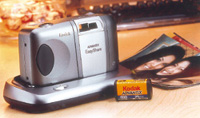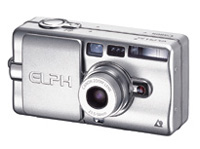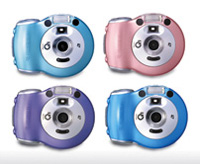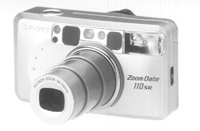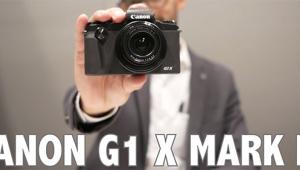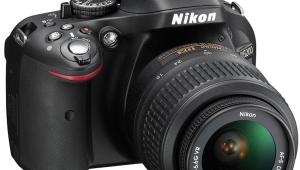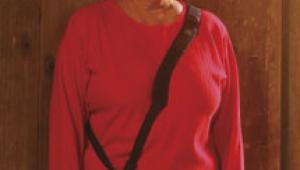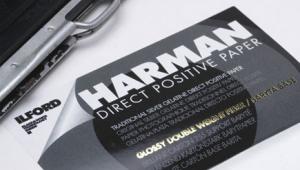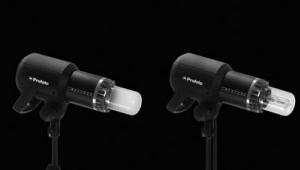35mm And APS Compact Cameras
Although everyone at the PMA show wanted to check out the new digital equipment, the compact lens/shutter film cameras still outsell such models. Most manufacturers continue to offer both formats: 35mm and Advanced Photo System (APS or 24mm). Such cameras have been made for decades so we didn't expect to see many radical changes. Nonetheless, a few Minolta and Canon models do include some entirely new technology. What's more obvious is that many such cameras have been downsized. Most of the new models are slimmer and lighter in weight than their predecessors. As well, more and more models feature a metal exterior, increasing their visual and tactile appeal. Although dozens of cameras were introduced, I'll review only those that might be of primary interest to Shutterbug readers. APS Cameras In fact, the single most interesting compact camera announced so far this year is an APS format autofocus model. To be available only in early 2003, the Advantix Easy Share is actually a hybrid, combining the benefits of film and digital imaging. Offering the best of both worlds, this Kodak model takes pictures on Advantix film but also records a digital image. After taking a shot, you can view your pictures immediately, including the probable exposure level. If you don't like the exposure or the composition, simply re-shoot the picture. You can also press a button to tell the camera (and the photofinisher) how many prints you'll want (including zero) from each of the negatives. The image preview feature is already available with the first generation Advantix Preview model, but the Advantix Easy Share offers some significant new features. Instead of storing only one image, the new camera can store 72 screen resolution pictures. Image file size will be small, probably 640x320 pixels, but more than adequate for Internet use. Any of the images can also be downloaded to a computer and sent by e-mail with the touch of a button on the accessory docking station (included). This autofocus camera is equipped with a 2x digital zoom and multimode flash plus the Kodak Picture Software and will be surprisingly affordable. (Estimated Street Price: $200.) |
|
Canon's ELPH series has been extremely successful and now includes a new model, the ELPH Z3. Completely redesigned, it has a more streamlined look. Attractively finished in aluminum alloy with chrome-plated parts, it's even more elegant than its predecessors. Measuring 3.9x2.0x1.3" and weighing a mere 5.3 oz, the new ELPH Z3 is very portable. It features a 23.5-54mm f/4.8-7.6 zoom lens (29.4-67.5mm equivalent in 35mm) including a molded aspherical element. (Street Price: $180.) The ELPH Z3 uses a newly-developed seven-zone, three-point AiAF CMOS passive autofocus system identical to the one described in the Sure Shot Z155 (35mm) section. It can immediately identify the main subject without the need to lock focus and recompose the image. In order to achieve even greater efficiency and performance, a 13-segment exposure metering system is integrated onto the same chip as the autofocus sensor for good exposures even in difficult lighting. Other capabilities include multimode flash, continuous autofocus, and full Magnetic Information Exchange (IX) for high quality photofinishing. |
|
Fujifilm's Nexia Q1 features a round body that comes in fashionable metallic colors: blue, cyan, pink, and purple. Small enough to fit into the palm of a hand, or a large shirt pocket, the Nexia Q1 is intended as a "cool" camera that will appeal to children and teens who want to snap pictures during vacations, parties, and other occasions. It includes all the basic features for great snapshots: autofocus, multimode flash, 22mm lens, drop-in film loading, and the choice of two APS formats: C and H, but not Panorama. My daughters (ages 16 and 21) both want one of these cameras, and their reaction suggests that the Fujifilm Nexia Q1 will become a best seller. Considering the Street Price (roughly $50, including battery and a roll of film) this model may replace single-use cameras as a favorite among children and teens. |
|
High Tech 35mm Point-And-Shoots |
|
Minolta introduced a new, highly sophisticated autofocus system, available in their Freedom Zoom 160 and 140 models. Called AREA-AF this technology is quite advanced and worth reviewing. Look through the viewfinder and the eyepiece sensors automatically activate the AF system. A large, multi-line CCD sensor differentiates between people and objects; then the system evaluates subject shape, distance, location, and brightness. Target AF automatically adjusts focus and exposure for the primary subject, usually a person if one is included in the frame. If the subject moves within the picture area, another AF sensor takes over focus. Note, too, that these cameras incorporate three autofocus options: the common wide area and spot modes, plus Target AF (described earlier) with continuous focus for moving subjects. Minolta has received accolades for their technology: the largest focus detection area of any film camera; the first camera with (human) subject detection; unique Matrix autofocus indication in the viewfinder and automatic LED brightness control. The new models also offer advanced subject-weighted 125-zone evaluative metering for optimum exposure; Eye-Start automation; new high-speed AF motor; autofocus with 942 steps and a 32-bit RISC processor for high-speed AF with true predictive continuous tracking focus for maximum accuracy with moving subjects. According to Minolta, they now offer "the world's fastest (two or three times faster) focusing compact cameras with 3x or greater zoom." |
|
Considering the above, I was amazed at the moderate prices of the new Minolta models with AREA-AF ($180 and $200). They feature slim, lightweight aluminum bodies and weigh only 6.9 oz. The Freedom Zoom 140 has a 37.5-140mm f/5.4-11.7 zoom, while the Freedom Zoom 160 extends to 160mm (f/5.4-12.4). Both include two aspherical elements for high image quality. These are uncomplicated cameras with Program mode, sophisticated multimode flash with exposure compensation control, zoom finder, an optional remote controller, and more. |
|
Long Zoom Point-And-Shoots
Fujifilm's new Zoom Date 1300 is also a highly compact camera in a metallic body; it's said to be the "world's smallest and lightest (6.35 oz) 4x zoom model." Note that this is one of the very few cameras with a long zoom that starts at 28mm: it's a 28-130mm f/5.8-11.5 lens with pro-grade EBC multi-coating. What's also impressive is the huge LCD data panel and thumb pad, both borrowed from digital camera designs. The Fujifilm Zoom Date 1300 includes a multimode flash with Programmed Zoom that automatically adjusts flash power for subject distance as well as ambient light. Other features include passive AF system, Macro and Landscape focusing modes, date imprinting, and an optional remote controller. (List Price: $350.) |
|
Available at a more moderate price, the new Fujifilm Zoom Date 125 SR includes a more typical lens: 38-125mm f/5.3-10.5. This camera (under 7 oz) sports a new champagne color with a gold trim, making it very stylish. The Fujifilm Zoom Date 125 SR employs an active infrared AF system and features a Program mode, multimode auto zoom flash and Easy Loading system. The kit includes a remote controller unit. Nearly identical, the Fujifilm Zoom Date 110 SR incorporates a 38-110mm f/6.5-11.7 zoom. (List Prices: $260 and $200.) |
|
Rollei makes many compact 35mm cameras. Their new model with a long zoom is the Prego 160 with a Vario Apogon 38-160mm f/5.8-12.6 zoom of German design. This is a handsome model with aluminum front shell and an illuminated, and huge, LCD menu panel on the back. That feature plus a thumb pad control make it reminiscent of a digital camera with maximum convenience for selecting various functions. The most notable Prego 160 feature is a variable power flash: it automatically reduces output for close-up shots to prevent overexposure or a harsh lighting effect. This is a Program camera with several flash modes, date imprinting, diopter correction eyepiece, Panorama Frame mode, and wide area passive autofocus system. (List Price: $329.) |
|
Nikon bills their Lite-Touch 130ED/QD as "the world's smallest and lightest 35mm camera with sliding lens cover and 3.4x zoom." It is small and lightweight (6.7 oz) but sports a 38-130mm f/5.3-10.5 lens with ED (Extra low Dispersion) glass that promises "incredibly sharp photographs." Advanced autofocus is also included: a 628-step wide area passive AF system should ensure excellent focus accuracy, even for off-center subjects at any distance. Other niceties include five-mode flash, date imprinting, Panorama Frame mode, diopter correction eyepiece, and an optional remote control unit. (List Price: $255.) |
|
Boasting the longest lens of any of the compact cameras introduced at the PMA show, the Samsung Maxima 170 GLM QD includes a 38-170mm "high definition" zoom and passive, multi-point autofocus system. Samsung did not yet have full specs on this model, but it includes multimode flash, date imprinting back, and a Panorama Frame mode. (List Price: $330.) |
|
Similar Samsung models with shorter lenses include the Maxima Zoom 140Ti ($280) with a 38-140mm f/4.7-12.2 zoom and the 120Ti ($180) with a 38-120mm f/4.5-13.1 zoom. These are close-focusing (to under 3") "high definition" lenses with two aspherical elements. Both models include a date back, diopter correction eyepiece, five subject-specific Program modes, plus continuous AF for moving subjects, employing a multi-point passive system. The 140Ti has some extras: Panorama Frame mode, backlight control, slow sync flash, dial mode button, and caption imprinting. Samsung also offers the new Fino 120 Super QD model that's very similar to the 120Ti but using active autofocus and without continuous AF. (List Price: $200.) |
|
Samsung also makes another line with "Italian design" and superior lens, called Pronta. Available in "limited quantities," the Pronta 1200QD (7.4 oz) sports a 38-120mm f/4.8-12.4 Schneider-Kreuznach Variopolan lens. Features include active AF with Continuous mode, basic multimode flash, illuminated LCD data panel, caption/date imprinting, mid roll rewind, Program mode, and a Bulb mode for exposures up to 60 sec long. (List Price: $220.) In Samsung's Evoca line, intended for the "photo enthusiast," we found several new models with Schneider-Kreuznach zoom lenses, including the Evoca 140 Neo QD and the 170 Neo QD. The first has a 38-140mm f/4.6-12.2 zoom while the other model has a 38-170mm zoom. Both are housed in a stylish aluminum body, and offer many features: two Program modes, Bulb for long exposures, continuous autofocus, date/caption imprinting, and advanced multimode flash. The 170 Neo QD is the flagship of the line and offers some extras: passive (not active) multi-point autofocus, Panorama Frame mode, and backlight compensation control. (List Prices: $300 and $320.) |
|
Cameras With Moderate Zooms
Rollei also offers a camera with a 28mm focal length, the Prego 100WA with high grade Vario 28-100mm f/5.8-10.5 zoom designed in Germany. Other than the lens, it is identical to the Prego 160 discussed earlier, and also features the oversized and illuminated LCD menu panel and thumb pad controls. At 5.6 oz, it's one of the lightest cameras in its category. (List Price: $299.) |
|
The new Pentax IQZoom 115V is also a very compact and moderately lightweight camera (8.5 oz) with a 38-115mm f/4.3-12.2 zoom that will focus down to a mere 2.6. This is an uncomplicated model with the basic capabilities: a Program mode, active AF system, zoom finder, and advanced flash system. (List Price: $150.) |
